Home : Travel : Berlin and Prague : Part 2
I spent the next days with John, an old friend from Boston. A white male graduating from a top school with a Ph.D. in science or engineering has his choice of career opportunities: (1) five years of post-doc purgatory before moving on to greater challenges, such as (2) hands-on optimization of small-scale urban transit systems (driving a cab). John, with a mathematics Ph.D., could only envy those with such vistas. Thousands of brilliant established Russian mathematicians, all with extensive records of publication in international journals, are applying for the same entry-level jobs in American universities as recent American graduates. John came to a German university two years ago and doesn't know when he'll return.
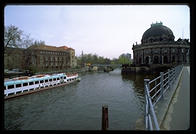 We started our program of megatourism at the Pergamon Museum, whose
main treasure is a temple frieze lifted from the city state of
Pergamon (currently part of Turkey). This was built around 170
B.C. and celebrates the triumph of the Greek gods over a random
assortment of giants. Gods are depicted with calm, cold, collected
expressions while they inflict all kinds of horrible injuries upon the
giants who wear expressions of agony as they fall helplessly. John
was convinced that a slim 18-year-old blonde in the museum had been
following us, but I managed to drag him away to the old Jewish
quarter, which is one of the more peaceful spots in the city (it is
not on the "old Prussian Berlin" or "wonderful modern Berlin" tours
that Germans take, so we saw just a handful of foreign tourists).
We started our program of megatourism at the Pergamon Museum, whose
main treasure is a temple frieze lifted from the city state of
Pergamon (currently part of Turkey). This was built around 170
B.C. and celebrates the triumph of the Greek gods over a random
assortment of giants. Gods are depicted with calm, cold, collected
expressions while they inflict all kinds of horrible injuries upon the
giants who wear expressions of agony as they fall helplessly. John
was convinced that a slim 18-year-old blonde in the museum had been
following us, but I managed to drag him away to the old Jewish
quarter, which is one of the more peaceful spots in the city (it is
not on the "old Prussian Berlin" or "wonderful modern Berlin" tours
that Germans take, so we saw just a handful of foreign tourists).
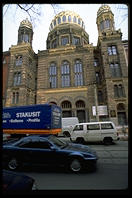 Die Neue Synagoge on Oranienburger Strasse had a tired Oriental look and
was under restoration. This building demonstrates the power of a single
person of conscience. When the Nazis rolled around on
Reichkristallnacht and set fire to the synagogue, a lone
policeman decided that it was a valuable historical building. He got a
fire brigade to put the fire out and then arranged an all-night guard
for the place. His efforts were ultimately in vain, for the Nazis had
learned something from the Turks in Athens: when you want something to
be destroyed, e.g. the Parthenon, put a lot of explosive stuff
inside and wait for an accident. Thus the building was used as an ammo
dump and an Allied bomb blew the place to smithereens in 1943.
Die Neue Synagoge on Oranienburger Strasse had a tired Oriental look and
was under restoration. This building demonstrates the power of a single
person of conscience. When the Nazis rolled around on
Reichkristallnacht and set fire to the synagogue, a lone
policeman decided that it was a valuable historical building. He got a
fire brigade to put the fire out and then arranged an all-night guard
for the place. His efforts were ultimately in vain, for the Nazis had
learned something from the Turks in Athens: when you want something to
be destroyed, e.g. the Parthenon, put a lot of explosive stuff
inside and wait for an accident. Thus the building was used as an ammo
dump and an Allied bomb blew the place to smithereens in 1943.
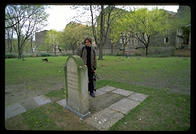 The nearby Jewish cemetery now contains only one gravestone: that of
Moses Mendelssohn.
The Nazis were aware that Jews, unlike Christians,
preserve old graves indefinitely as sacred ground. They took special
care therefore to not only smash all the tombstones, but also to dig
up the bones of the 12,000 people buried there. Immediately to the
left of the cemetery are two Soviet-sponsored reminders of Nazi days:
a sculpture of emaciated concentration camp inmates and a tablet
marking the collection point for 55,000 Berlin Jews on their way to
labor and death camps.
The nearby Jewish cemetery now contains only one gravestone: that of
Moses Mendelssohn.
The Nazis were aware that Jews, unlike Christians,
preserve old graves indefinitely as sacred ground. They took special
care therefore to not only smash all the tombstones, but also to dig
up the bones of the 12,000 people buried there. Immediately to the
left of the cemetery are two Soviet-sponsored reminders of Nazi days:
a sculpture of emaciated concentration camp inmates and a tablet
marking the collection point for 55,000 Berlin Jews on their way to
labor and death camps.
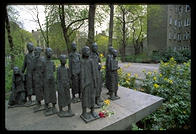
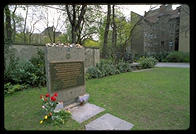
The rest of the quarter was devoid of tourist
attractions, unless you count a 10-year-old boy hollering at us for
crossing a tiny street against the "don't walk" signal.
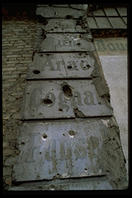 We ventured deeper into East Berlin and were struck by the general
shabbiness of the place. Every building facade is pock-marked with
shell and bullet holes. It was easy to remember that the Red Army
lost about as many soldiers in the Battle of Berlin as the U.S. Army
lost in all of WWII fighting both the Japanese and Germans. Fighting
was at such close range that artillery shells had to be refused to
explode after flying only a block or two.
We ventured deeper into East Berlin and were struck by the general
shabbiness of the place. Every building facade is pock-marked with
shell and bullet holes. It was easy to remember that the Red Army
lost about as many soldiers in the Battle of Berlin as the U.S. Army
lost in all of WWII fighting both the Japanese and Germans. Fighting
was at such close range that artillery shells had to be refused to
explode after flying only a block or two.
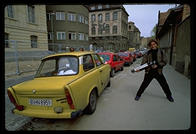 Even if the war damage were repaired, life in East Berlin would be
far from sybaritic. The predominant car is the Trabbi which makes a
Volkswagen seem positively luxurious. None of the little shops had a
cold drink for sale and it occurred to me that simple tasks can be
very time-consuming here. For example, in any boulangerie in
France one can get a sandwich, cold drink, and napkin. In Germany,
buying the same items might involve visiting three stores. John
ducked into a big new supermarket looking for limes or lime juice but
found neither. He'd been looking all over northern Germany for weeks
without success because German supermarkets only carry about 10-20% of
the items an American supermarket might have. Ethnic food here is
corn chips.
Even if the war damage were repaired, life in East Berlin would be
far from sybaritic. The predominant car is the Trabbi which makes a
Volkswagen seem positively luxurious. None of the little shops had a
cold drink for sale and it occurred to me that simple tasks can be
very time-consuming here. For example, in any boulangerie in
France one can get a sandwich, cold drink, and napkin. In Germany,
buying the same items might involve visiting three stores. John
ducked into a big new supermarket looking for limes or lime juice but
found neither. He'd been looking all over northern Germany for weeks
without success because German supermarkets only carry about 10-20% of
the items an American supermarket might have. Ethnic food here is
corn chips.
We stopped into the Humboldt University Physics Department so that John could use Internet, the worldwide network linking millions of computer users. East Germany must not have been all bad; hospitality at Humboldt reminded me of New Zealand. Herr Professor Doctor Thiele stopped what he was doing and walked us 100m down a corridor to some associates with a lame old IBM PC-clone. They quit their program, rebooted the machine for us, then waited patiently while John connected to his home computer in Bielefeld and read his mail. As we were walking out, Dr. Thiele showed us a vacuum deposition machine and posters derived from research papers. We were invited for coffee and everyone wanted to know about our touring program so they could recommend things and help us. They were knowledgeable about Nazi and Jewish sites and didn't seem surprised at our interests. A lab technician actually walked down three flights of stairs and across the street to get us to the natural history museum's reconstructed dinosaurs.
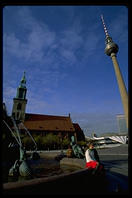 Just a block or two from the dinosaurs, we had our first Käthe
Kollwitz flashback of the day: the East German monument to early
German Communist Karl Liebknecht, whom Kollwitz had portrayed
following his murder by rightist thugs. We strolled past the Bertolt
Brecht house and caught a bus to the sterile monumental
Alexanderplatz. This ugly East German wasteland has been further
despoiled by garish signs advertising Western products: Panasonic,
Pioneer, Coca-Cola, etc. For five marks we rode to the top of the
360m high television tower (roughly the height of the World Trade
Center, not as high as the towers in Moscow or Toronto).
Here one can
"sit on it and rotate" in a cafe with that good old surly Communist
service: a request for a Coke, a liqueur, and some tapwater was met
with refusal on the tapwater score. First our waitress said that they
had no tapwater, but when pressed admitted they had some but couldn't
serve it "for health reasons." Presumably she was referring to their
financial health; they are perfectly happy to serve it to you heated
slightly and with a teabag. Despite the shocking prices, indifferent
service, and smoking clientele, the view was more than worth it. The
difference between East and West Berlin was very evident from this
vantage and the day just got sunnier with every hour.
Just a block or two from the dinosaurs, we had our first Käthe
Kollwitz flashback of the day: the East German monument to early
German Communist Karl Liebknecht, whom Kollwitz had portrayed
following his murder by rightist thugs. We strolled past the Bertolt
Brecht house and caught a bus to the sterile monumental
Alexanderplatz. This ugly East German wasteland has been further
despoiled by garish signs advertising Western products: Panasonic,
Pioneer, Coca-Cola, etc. For five marks we rode to the top of the
360m high television tower (roughly the height of the World Trade
Center, not as high as the towers in Moscow or Toronto).
Here one can
"sit on it and rotate" in a cafe with that good old surly Communist
service: a request for a Coke, a liqueur, and some tapwater was met
with refusal on the tapwater score. First our waitress said that they
had no tapwater, but when pressed admitted they had some but couldn't
serve it "for health reasons." Presumably she was referring to their
financial health; they are perfectly happy to serve it to you heated
slightly and with a teabag. Despite the shocking prices, indifferent
service, and smoking clientele, the view was more than worth it. The
difference between East and West Berlin was very evident from this
vantage and the day just got sunnier with every hour.
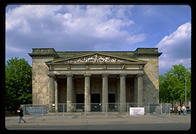 After being whisked down from the tower, we walked up Unter den Linden
toward the Brandenburg Gate. We got sidetracked at the Marx-Engels
statue where John stuck a 100-mark note in Marx's hand for a photo.
Our next Käthe Kollwitz flashback was The Neue Wache (new watch),
the famous architect Schinkel's first big commission. It was supposed
to celebrate victory over Napoleon and was designed as a guardhouse
for the Kaiser's Palace across the street. (You can't see the
Kaiser's Palace, which was bombed by the Allies and then pulled down
by the anti-Royalist East Germans to make room for some kind of
People's palace.) It looks kind of like a Roman Temple, which is
perhaps why it became Germany's unknown soldier monument after the
First World War. Hitler remade it slightly into a monument glorifying
militarism and victorious Russians turned it into a monument to the
victims of fascism, i.e., the Nazis.
After being whisked down from the tower, we walked up Unter den Linden
toward the Brandenburg Gate. We got sidetracked at the Marx-Engels
statue where John stuck a 100-mark note in Marx's hand for a photo.
Our next Käthe Kollwitz flashback was The Neue Wache (new watch),
the famous architect Schinkel's first big commission. It was supposed
to celebrate victory over Napoleon and was designed as a guardhouse
for the Kaiser's Palace across the street. (You can't see the
Kaiser's Palace, which was bombed by the Allies and then pulled down
by the anti-Royalist East Germans to make room for some kind of
People's palace.) It looks kind of like a Roman Temple, which is
perhaps why it became Germany's unknown soldier monument after the
First World War. Hitler remade it slightly into a monument glorifying
militarism and victorious Russians turned it into a monument to the
victims of fascism, i.e., the Nazis.
As soon as the Russians cleared out, people agitated to turn the thing into yet another monument to the victims of Stalin, but eventually settled for a universalist monument to victims of all wars. A Kollwitz statue will be the centerpiece of the monument. Thus will the artist who fought against the government in 1933 posthumously assist today's German government in erasing the memory of the Nazi period.
We resolved to walk until we came to an S-Bahn station, but ended up stuck in the transitless wilderness of the Tiergarten, just past the lovely Soviet memorial to the heroic Red Army. A tough Russian soldier stands atop a semicircular colonnade, flanked by howitzers and two T-34 tanks. It must be pretty irritating to locals who drive by this all the time. Imagine a monument to B29 bombers in the middle of downtown Tokyo.
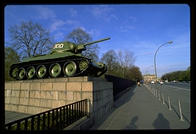
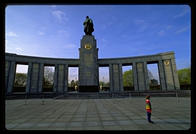
While we stood at a street corner, cluelessly leafing through various guidebooks, an Aryan goddess stopped on her bicycle and asked (in beautiful English) if she could help us. We explained our problem, and she told us that all S-Bahn stations were a 15-minute walk. She directed us past the Reichstag to the main Friedrichstrasse interchange. Meanwhile, she had utterly charmed us with her smile and friendliness. After she left, John couldn't stop talking about her perfect skin, "intelligent hair," and generally remarkable personality. He mentioned all the things we should have said to her to get her phone number and spend more time with her. I said that if we'd let an opportunity like that pass us by, we deserved to be single and lonely.
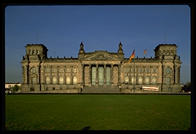 It was fixing to be a beautiful sunset on the Reichstag and I set up
my tripod in the middle of a vast lawn for a photo.
It was fixing to be a beautiful sunset on the Reichstag and I set up
my tripod in the middle of a vast lawn for a photo.
[The Reichstag
contains an exhibit, "Questions on German History," that is very
popular for public school trips and famous among the local diplomats
for its whitewashing of the Nazi period. It was, closed, however, so
we couldn't see for ourselves.] History seemed palpable as I stood in
front of the building whose burning provided Hitler with an excuse to
declare a state of emergency. This was the beginning of Germany's
quick slide from constitutional democracy to dictatorship and I
thought about the complacency with which Americans have given up so
many civil rights in the name of the Drug War.
John and I S-Bahned to the Wannsee the next day and considered a walk down to Heinrich von Kleist's grave. This writer's death was called by Friedrich de la Motte Fouqué "one of the most marvelous suicides of all time." In 1861, Max Ring wrote an allegedly superb tribute to Kleist that was placed here on a marble slab. However, we decided to skip the grave because the Nazis ripped up the tribute in 1936 (due to Ring having been Jewish) and replaced it with something boring.
Anxious to rest our flat fleet, we caught a tour boat to Potsdam under
blue skies. Our cruise was narrated (in German only) by a man with an
enthusiasm for detail. We learned the speed of the boat, the history
of villas built by cousins of brother-in-laws of cousins of obscure
German princes, the past and present uses of patches of forest and
islands, all while breathing that famous refreshing Berlin air.
Although the lake doesn't offer the dramatic scenery of, say, Lake
Tahoe, it is remarkable to find such a peaceful beautiful place so
close to a large city.
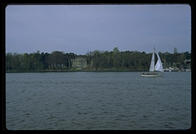 As we passed the famous Villa am Grossen Wannsee (site of the January
20, 1942 Final Solution conference), our guide's fund of history dried
up and it received only passing mention ("on the left is the Villa am
Grossen Wannsee, on the right the beautiful sandy Wannsee beach").
As we passed the famous Villa am Grossen Wannsee (site of the January
20, 1942 Final Solution conference), our guide's fund of history dried
up and it received only passing mention ("on the left is the Villa am
Grossen Wannsee, on the right the beautiful sandy Wannsee beach").
The weather turned greyer and colder as we cruised under the famous Glienicker Bridge and learned about all the East-West spy exchanges held here, including that of U2 pilot Gary Powers and dissident Natan Scharansky. We put on more clothing and stayed on deck as we crossed back to former East Germany and its unmistakable air of shabbiness, rubble, and reconstruction. As we lounged on the deck amidst a group of older Germans, John remarked how pathetic it was that, at the ages of 29 and 30, we were living like retired people. I said that we should have brought a shuffleboard set.
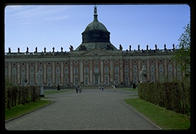 We walked through Downtown Potsdam and over to Frederick the Great's
Sans Souci (without a care) castle. Fred admired Louis XIV and
built his gardens and palace in imitation of Versailles. Although the
place offered fountains, serenity, vast lawns, broad avenues, hundreds
of sculptures, immense palaces, something was hideously wrong. I was
reminded of Rémy de Gourmont: The copy of a beautiful thing is
always an ugly thing. It is an act of cowardice in admiration of an act
of energy.
We walked through Downtown Potsdam and over to Frederick the Great's
Sans Souci (without a care) castle. Fred admired Louis XIV and
built his gardens and palace in imitation of Versailles. Although the
place offered fountains, serenity, vast lawns, broad avenues, hundreds
of sculptures, immense palaces, something was hideously wrong. I was
reminded of Rémy de Gourmont: The copy of a beautiful thing is
always an ugly thing. It is an act of cowardice in admiration of an act
of energy.
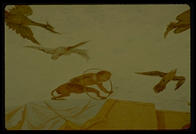 My favorite spot was the Chinese teahouse, where the ceiling paintings
include a monkey bearing Voltaire's features. It seems that Voltaire
was a house guest here for three years and he and the king parted on
bad terms. A year later, the monkey showed up. People with money did
more interesting things in the old days.
My favorite spot was the Chinese teahouse, where the ceiling paintings
include a monkey bearing Voltaire's features. It seems that Voltaire
was a house guest here for three years and he and the king parted on
bad terms. A year later, the monkey showed up. People with money did
more interesting things in the old days.
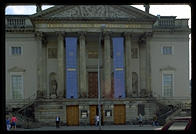 John caught a train back home to north-central Germany, and I met
Jean and Carlos at the Deutsche Staatsoper
(the Communist opera
company) for a performance of La Traviata. This grand building
with crystal-clear acoustics was completed in 1743 and houses only
about half as many people as the Met. The Royal Air Force opened up
the roof and redecorated the interior during the war then the place
was rebuilt in the style and quality of a Marriott banquet room. When
the curtain rose, there was nothing but a bare stage and a few
sewn-together bedsheets where the Metropolitan Opera would have
million dollar sets showing Paris better than it ever was.
John caught a train back home to north-central Germany, and I met
Jean and Carlos at the Deutsche Staatsoper
(the Communist opera
company) for a performance of La Traviata. This grand building
with crystal-clear acoustics was completed in 1743 and houses only
about half as many people as the Met. The Royal Air Force opened up
the roof and redecorated the interior during the war then the place
was rebuilt in the style and quality of a Marriott banquet room. When
the curtain rose, there was nothing but a bare stage and a few
sewn-together bedsheets where the Metropolitan Opera would have
million dollar sets showing Paris better than it ever was.
The opera was a great window into East Germany. It looked as though they'd mustered up money to rebuild the place, albeit shabbily. Then they managed to get an orchestra to follow the conductor's commands and a group of singers with no obvious technical flaws (although they were the thickest-waisted Parisiennes you ever saw). Out of funds, they had to borrow sets and equipment from an American junior high school. Thus, when the gypsies were rolled out during Flora's party, the creaking of their dancing platform drowned out their voices at times. Still, an $8 student ticket here beats sitting in the back of the Met for $20 with a telescope.
 Go to Part 3 (Soviet and Turkish voices in Berlin)
Go to Part 3 (Soviet and Turkish voices in Berlin)
philg@mit.edu
Add a comment | Add a link
 We started our program of megatourism at the Pergamon Museum, whose
main treasure is a temple frieze lifted from the city state of
Pergamon (currently part of Turkey). This was built around 170
B.C. and celebrates the triumph of the Greek gods over a random
assortment of giants. Gods are depicted with calm, cold, collected
expressions while they inflict all kinds of horrible injuries upon the
giants who wear expressions of agony as they fall helplessly. John
was convinced that a slim 18-year-old blonde in the museum had been
following us, but I managed to drag him away to the old Jewish
quarter, which is one of the more peaceful spots in the city (it is
not on the "old Prussian Berlin" or "wonderful modern Berlin" tours
that Germans take, so we saw just a handful of foreign tourists).
We started our program of megatourism at the Pergamon Museum, whose
main treasure is a temple frieze lifted from the city state of
Pergamon (currently part of Turkey). This was built around 170
B.C. and celebrates the triumph of the Greek gods over a random
assortment of giants. Gods are depicted with calm, cold, collected
expressions while they inflict all kinds of horrible injuries upon the
giants who wear expressions of agony as they fall helplessly. John
was convinced that a slim 18-year-old blonde in the museum had been
following us, but I managed to drag him away to the old Jewish
quarter, which is one of the more peaceful spots in the city (it is
not on the "old Prussian Berlin" or "wonderful modern Berlin" tours
that Germans take, so we saw just a handful of foreign tourists).













